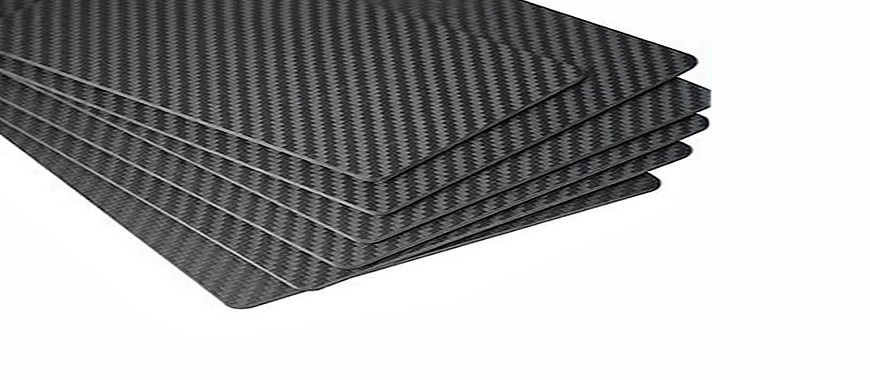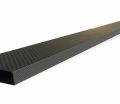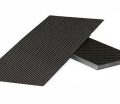
Composite materials are widely used for their strength, lightweight properties, and versatility. They are engineered by combining two or more distinct materials to achieve superior performance. Among these, carbon fiber tape and fiberglass are highly recognized for their specific attributes. However, understanding whether can carbon fiber tape be used as fiberglass requires a deeper look at their differences and applications. Knowing these distinctions ensures materials are used effectively in the right contexts. Questions about interchangeability often arise due to similarities in their uses. However, the answer to can carbon fiber tape be used as fiberglass depends on factors like mechanical properties and application needs. Selecting the appropriate material is crucial for achieving optimal results, especially in high-performance or cost-sensitive projects.
Material Properties Comparison: Can Carbon Fiber Tape Be Used as Fiberglass?
When considering can carbon fiber tape be used as fiberglass, it is essential to analyze the properties of each material. Carbon fiber tape and fiberglass have unique characteristics that make them suitable for different applications. This section explores their composition, key attributes, and performance differences.
Carbon Fiber Tape Properties
Composition of Carbon Fiber Tape
Carbon fiber tape consists of unidirectional carbon strands bonded together to form a lightweight, durable material. The strands are arranged in a single direction, providing exceptional tensile strength and rigidity. This structure ensures that the tape maintains consistent mechanical properties along its length, making it ideal for reinforcement purposes.
Key Attributes
- Strength: Carbon fiber tape offers unparalleled strength-to-weight ratios. It is significantly stronger than many other composite materials, including fiberglass.
- Lightweight: One of its defining features is its minimal weight. Carbon fiber tape is ideal for applications where reducing overall mass is critical.
- High Tensile Modulus: Its high stiffness allows it to resist deformation under heavy loads, making it perfect for structural components.
These attributes make carbon fiber tape a superior choice for high-performance projects. However, its suitability as a fiberglass substitute depends on specific use cases, as discussed further.
Fiberglass Properties
Composition of Fiberglass
Fiberglass is made by melting glass into fine strands, which are then woven or layered into mats or fabrics. This composition gives fiberglass flexibility and adaptability for various shapes and forms. It is commonly reinforced with resins to enhance strength and durability.
Attributes of Fiberglass
- Corrosion Resistance: Fiberglass is resistant to moisture, chemicals, and UV rays, making it durable in harsh environments.
- Affordability: Fiberglass is more cost-effective than carbon fiber, making it a preferred choice for budget-conscious projects.
- Flexibility: The material can be easily molded into different shapes, offering versatility for numerous applications.
These properties highlight the practicality of fiberglass, particularly for applications where cost and corrosion resistance are more important than extreme strength or lightweight design.
Differences in Performance
| Property | Carbon Fiber Tape | Fiberglass |
|---|---|---|
| Tensile Strength | High (over 20% stronger) | Moderate |
| Weight | Lightweight (up to 15% lighter) | Heavier |
| Cost | Expensive | Cost-effective |
Situations Where One Outperforms the Other
- High Strength Applications: Carbon fiber tape excels in areas requiring extreme strength and rigidity, such as aerospace or high-speed vehicles.
- Corrosive Environments: Fiberglass is ideal for marine and industrial projects due to its excellent resistance to environmental factors.
- Cost-Sensitive Projects: Fiberglass offers a budget-friendly solution for large-scale applications without compromising durability.
Understanding these differences is critical to answering can carbon fiber tape be used as fiberglass. While carbon fiber tape may replace fiberglass in some cases, its cost and specific properties must be weighed against the requirements of the project.
The Importance of Performance Analysis
When deciding can carbon fiber tape be used as fiberglass, evaluating performance is crucial. Selecting the right material can impact the project’s success, durability, and cost-efficiency. Both materials offer unique advantages, and understanding their differences helps in making informed decisions for specialized needs.
How to Choose Fiberglass Carbon Fiber Adhesive Wisely
Applications of Carbon Fiber Tape and Fiberglass
Understanding whether can carbon fiber tape be used as fiberglass requires an evaluation of its applications and limitations. Both materials serve unique purposes and excel in different scenarios. This section explores their potential uses and compatibility.
Can Carbon Fiber Tape Be Used as Fiberglass?
Carbon fiber tape is often considered for replacing fiberglass in various applications, such as sheets, drywall reinforcement, or general structural support. While the materials share similarities, their mechanical properties differ significantly.
Mechanical Property Compatibility
Carbon fiber tape’s high tensile strength and stiffness make it ideal for applications requiring lightweight durability. However, fiberglass is more flexible and corrosion-resistant, making it better suited for specific environmental conditions. Compatibility depends on whether the project demands rigidity or adaptability. For instance:
- In structural reinforcement, carbon fiber tape performs exceptionally where lightweight strength is needed.
- For environmental durability, fiberglass remains a preferred option due to its resistance to moisture and chemicals.
Careful evaluation of these factors ensures the right material is chosen, addressing the core question of can carbon fiber tape be used as fiberglass effectively.
Use Cases for Carbon Fiber Tape
Carbon fiber tape finds widespread use in industries that prioritize strength and lightweight properties. Its high performance makes it invaluable in:
- Automotive Industry: Used for reducing weight and enhancing structural strength in vehicles.
- Aerospace Applications: Essential for building lightweight, durable components in aircraft and spacecraft.
- RC Aircraft: Offers structural reinforcement while minimizing additional weight.
- General Structural Reinforcement: Ideal for enhancing the rigidity of composite panels or frameworks.
Benefits for High-Performance and Lightweight Needs
Carbon fiber tape offers significant advantages in high-performance applications:
- Improved Efficiency: Reduces weight without compromising strength, enhancing performance in vehicles and aircraft.
- Extended Lifespan: Withstands extreme loads and harsh conditions, offering superior durability compared to other materials.
- Customizability: Available in various widths and thicknesses, catering to diverse project requirements.
However, its cost can be a limiting factor for large-scale use, making fiberglass a more practical alternative in cost-sensitive scenarios.
Use Cases for Fiberglass
Fiberglass is a versatile material used extensively in construction, marine, and industrial applications. Its affordability and adaptability make it an excellent choice for:
- Construction Projects: Reinforces walls, roofing, and insulation, offering durability and flexibility.
- Marine Applications: Provides excellent resistance to saltwater, making it ideal for boat hulls and docks.
- Industrial Contexts: Used in piping, storage tanks, and other industrial structures requiring corrosion resistance.
Cost-Effective Solutions for General-Purpose Needs
Fiberglass is valued for its practical benefits:
- Affordability: A budget-friendly option compared to carbon fiber, especially for large projects.
- Environmental Resistance: Performs well in humid or corrosive environments without significant maintenance.
- Ease of Use: Can be molded into various shapes, accommodating diverse design requirements.
While fiberglass is not as strong or lightweight as carbon fiber tape, its cost-effectiveness and environmental durability address the question of can carbon fiber tape be used as fiberglass in specific scenarios.
The Importance of Application-Specific Selection
When determining whether can carbon fiber tape be used as fiberglass, the application plays a pivotal role. Each material has distinct strengths that align with different needs. Projects requiring high strength-to-weight ratios favor carbon fiber tape, while fiberglass remains a reliable and cost-effective solution for environmental durability and large-scale use. Careful consideration of these aspects ensures the best outcomes for any project.
Practical Considerations: Can Carbon Fiber Tape Be Used as Fiberglass?
When exploring can carbon fiber tape be used as fiberglass, several practical considerations must be examined. Factors such as weight, strength, compatibility with resins, and cost implications influence material selection. Understanding these aspects ensures the best choice for specific project requirements.
Weight and Strength
Comparative Analysis
Carbon fiber tape is significantly lighter than fiberglass while offering higher tensile strength. Its high strength-to-weight ratio makes it ideal for applications where minimizing weight is critical, such as aerospace, automotive, or RC aircraft.
Fiberglass, while heavier, provides adequate strength for general applications, making it a reliable option for cost-sensitive projects. Its weight is less critical in scenarios like construction or marine uses, where durability and corrosion resistance are more important.
Suitability for Different Designs
For high-load designs, carbon fiber tape provides superior performance due to its rigidity and strength. Lightweight structures benefit from carbon fiber’s reduced mass, enhancing efficiency and mobility. In contrast, fiberglass is better suited for applications that demand flexibility and adaptability to various shapes.
The choice between the two materials depends on project goals, addressing the question of can carbon fiber tape be used as fiberglass effectively.
Compatibility with Resins and Substrates
Bonding Considerations
Carbon fiber tape and fiberglass both require resin systems for bonding and durability. However, their compatibility with resins varies:
- Carbon Fiber Tape: Works best with epoxy resins, which enhance its strength and performance.
- Fiberglass: Compatible with polyester and vinyl ester resins, making it more versatile for large-scale applications.
Factors Influencing Durability
The bond between the material and resin significantly impacts performance. Carbon fiber tape forms a stiffer bond, ideal for high-performance applications, while fiberglass’s flexible bond allows it to withstand environmental stresses.
Understanding resin compatibility helps determine can carbon fiber tape be used as fiberglass in a specific context. Choosing the right resin enhances the material’s long-term reliability and performance.
Cost Implications
Carbon fiber tape is a premium material with higher production costs. Its use is justified in projects requiring high-performance results or lightweight designs. Fiberglass, on the other hand, is a cost-effective alternative that balances affordability with adequate performance.
When to Invest in Carbon Fiber Tape
- High-value projects, such as aerospace or competitive automotive designs, benefit from carbon fiber tape’s unique properties.
- Lightweight applications requiring superior strength-to-weight ratios justify the additional expense.
Fiberglass as a Budget-Friendly Alternative
Fiberglass is suitable for projects prioritizing affordability over extreme performance. It offers durability and environmental resistance at a fraction of the cost.
Understanding these cost factors ensures informed decisions about can carbon fiber tape be used as fiberglass, aligning materials with project budgets and requirements.
The Importance of Evaluating Practical Factors
Determining whether can carbon fiber tape be used as fiberglass relies heavily on practical considerations. Each material has strengths and limitations that suit different applications. By analyzing weight, strength, resin compatibility, and costs, project outcomes can be optimized for performance and efficiency. At GangLong Fiberglass, we focus on providing expert guidance to help you make the best choice for your unique needs.
Top Features of Fiberglass and Carbon Fiber Skim Board
Recommendations for Use: Can Carbon Fiber Tape Be Used as Fiberglass?
When deciding can carbon fiber tape be used as fiberglass, the selection depends on specific project requirements. Each material excels in particular scenarios, and understanding their suitability ensures optimal performance. Here, we provide recommendations for when to choose carbon fiber tape and when fiberglass is a better option.
When to Choose Carbon Fiber Tape
For High-Strength and Lightweight Applications
Carbon fiber tape is the ideal choice for projects requiring a combination of strength and low weight. Its high tensile strength and stiffness make it a superior material for applications where performance is critical, such as:
- Aerospace: Essential for reducing weight in aircraft components while maintaining structural integrity.
- Automotive: Used in high-performance vehicles to enhance speed, efficiency, and durability without adding unnecessary mass.
- RC Aircraft: Perfect for building lightweight and durable frames that can handle aerodynamic forces.
Best Practices for Use
To maximize its benefits:
- Apply carbon fiber tape in load-bearing areas to optimize strength.
- Pair it with high-quality epoxy resins to ensure durability and performance.
- Avoid overuse in non-critical areas to manage material costs.
These practices demonstrate why carbon fiber tape is often preferred in advanced projects, while still addressing the question can carbon fiber tape be used as fiberglass in similar scenarios.
When to Choose Fiberglass
For Cost-Effective Reinforcement
Fiberglass is a practical alternative when affordability and flexibility are more important than extreme strength or lightweight properties. It is widely used in:
- Construction: Reinforces walls, roofs, and insulation while offering durability at a lower cost.
- Marine Applications: Provides excellent resistance to saltwater and harsh environments, making it ideal for boat hulls and docks.
- General Industrial Use: Used for storage tanks, piping, and other applications requiring corrosion resistance.
Situations Where Fiberglass Excels
Fiberglass is particularly effective in:
- Large-Scale Projects: Its cost-effectiveness allows for extensive use without exceeding budgets.
- Environmental Durability: Performs well in humid, corrosive, or UV-exposed conditions, ensuring long-term reliability.
Fiberglass’s versatility and affordability make it a suitable choice in many cases, addressing the query of can carbon fiber tape be used as fiberglass and why fiberglass might still be preferred.
The choice between carbon fiber tape and fiberglass depends on the project’s specific needs. High-performance applications favor carbon fiber tape, while fiberglass provides cost-effective durability for general purposes. At GangLong Fiberglass, we guide clients to select the most appropriate material for their projects, ensuring success and efficiency.
Why Anglers Love Carbon Silica Fiberglass Hybrid Fly Rods
Final Insights: Can Carbon Fiber Tape Be Used as Fiberglass?
As we conclude the exploration of can carbon fiber tape be used as fiberglass, it is clear that each material serves distinct purposes. This section summarizes the key points and offers closing thoughts to help you make informed decisions.
Summary of Key Points
Strengths and Weaknesses
Carbon fiber tape and fiberglass are both exceptional materials, but they excel in different areas:
- Carbon Fiber Tape: Known for its high tensile strength, lightweight nature, and rigidity, it is ideal for high-performance applications. However, its cost may limit its use in budget-sensitive projects.
- Fiberglass: Offers excellent corrosion resistance, affordability, and flexibility, making it a versatile choice for large-scale or environmental applications. Its moderate strength and heavier weight, however, make it less suitable for advanced engineering projects.
Both materials have unique benefits and drawbacks. When deciding can carbon fiber tape be used as fiberglass, consider factors like budget, environmental conditions, and performance requirements.
The right material can enhance project outcomes. Selecting carbon fiber tape ensures unmatched performance, while fiberglass delivers cost-effective durability. Material choice should align with the specific needs of your application.
Final Thoughts
Assessing Project Requirements
Careful assessment of project goals is essential. Ask these questions:
- Does the project demand high strength-to-weight ratios?
- Is the environment harsh or corrosive?
- Are budget constraints a major concern?
These considerations determine whether carbon fiber tape or fiberglass is the better option. Evaluating these requirements ensures the chosen material meets both performance and cost expectations.
Consulting Experts
Choosing the right material can be challenging. Consulting experienced professionals helps clarify whether can carbon fiber tape be used as fiberglass for your specific application. At GangLong Fiberglass, we specialize in guiding our clients through this decision-making process. With our expertise, you can confidently select the material that aligns with your project needs and goals.
While both materials excel in their own domains, the best choice depends on the unique demands of your application. By considering all relevant factors, you can ensure a successful and efficient outcome.
FAQs about Can Carbon Fiber Tape Be Used as Fiberglass
Carbon fiber is generally stronger than fiberglass when it comes to tensile strength and stiffness. It provides superior performance in high-stress applications. Fiberglass, however, is more flexible and can withstand certain impacts better without cracking. The strength of each material depends on its intended use and design. While carbon fiber is preferred for projects requiring high strength-to-weight ratios, fiberglass is often chosen for cost-effectiveness and versatility. Determining whether carbon fiber tape can be used as fiberglass depends on the specific requirements of the application, such as load conditions and environmental factors.
Carbon fiber is less likely to cause itching compared to fiberglass. Fiberglass can produce small, sharp particles that irritate the skin, especially during cutting or sanding. Carbon fiber splinters can occur but are generally smoother and less irritating. Proper handling of both materials, including wearing gloves and protective clothing, minimizes skin discomfort. The comparison of whether carbon fiber tape can be used as fiberglass extends beyond irritation concerns and focuses more on mechanical properties and applications.
Carbon fiber can bond to fiberglass using appropriate resins, such as epoxy, to create a composite structure. The bond strength depends on the resin used and the surface preparation. Both materials must be clean and properly sanded for effective adhesion. This compatibility makes it possible to combine carbon fiber and fiberglass in certain designs. However, mixing the two requires careful consideration of their mechanical differences. When exploring whether carbon fiber tape can be used as fiberglass, understanding their bonding properties is crucial for successful integration.
Fiber and fiberglass are not the same. Fiber refers to any thin, elongated material, while fiberglass specifically consists of fine strands of melted glass. Fiberglass is a type of composite material used for structural reinforcement, insulation, and corrosion resistance. Carbon fiber, another type of fiber, is composed of carbon atoms and is much stronger and lighter than fiberglass. While both are fibers, they serve different purposes in construction and manufacturing. Deciding whether carbon fiber tape can be used as fiberglass requires understanding these distinctions and matching the material to the application’s needs.

As the editor of GangLong Fiberglass, I have years of experience and in-depth research, focusing on cable tray products, fiberglass solutions, and grille systems. I incorporate years of industry insights and practical experience into every content, committed to promoting the progress of the industry. At GangLong Fiberglass, my commitment is reflected in every product, from innovative cable trays to durable fiberglass solutions and sturdy grille systems. As an authoritative voice in the industry, my goal is to provide valuable information to professionals and businesses and promote forward-looking solutions.


